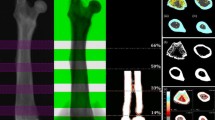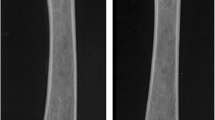Abstract
Bone mineral measurements with quantitative computed tomography (QCT) and dual-energy X-ray absorptiometry (DXA) were compared with chemical analysis (ChA) to determine (1) the accuracy and (2) the influence of bone marrow fat. Total bone mass of 19 human femoral necks in vitro was determined with QCT and DXA before and after defatting. ChA consisted of defatting and decalcification of the femoral neck samples for determination of bone mineral mass (BmM) and amount of fat. The mean BmM was 4.49 g. Mean fat percentage was 37.2% (23.3%–48.5%). QCT, DXA and ChA before and after defatting were all highly correlated (r>0.96,p<0.0001). Before defatting the QCT values were on average 0.35 g less than BmM and the DXA values were on average 0.65 g less than BmM. After defatting, all bone mass values increased; QCT values were on average 0.30 g more than BmM and DXA values were 0.29 g less than BmM. It is concluded that bone mineral measurements of the femoral neck with QCT and DXA are highly correlated with the chemically determined bone mineral mass and that both techniques are influenced by the femoral fat content.
Similar content being viewed by others
References
Cann CE. Quantitative CT for determination of bone mineral density: a review. Radiology 1988;166:509–22.
Revak CS. Mineral content of cortical bone measured by computed tomography. J Comput Assist Tomogr 1980;4:342–50.
Genant HK, Boyd DG. Quantitative bone mineral analysis using dual energy computed tomography. Invest Radiol 1977;12:545–51.
Peppier WW, Mazess RB. Total body bone material and lean body mass by dual-photon absorptiometry. I. Theory and measurement procedure. Calcif Tissue Int 1981;33:353–9.
Hangartner TN, Johnston CC. Influence of fat on bone measurements with dual-energy absorptiometry. Bone Miner 1990;9:71–81.
Pye DW. Estimation of the magnitude of the error in bone mineral measurement due to fat: the effect of machine calibration. Clin Phys Physiol Meas 1991;12:87–91.
Goodsitt MM. Evaluation of a new set of calibration standards for the measurement of fat content via DPA and DXA. Med Phys 1991;19:35–44.
Tothill P, Avenell A. Errors in dual-energy X-ray absorptiometry of the lumbar spine owing to fat distribution and soft tissue thickness during weight change. Br J Radiol 1994;67:71–5.
Dunnill MS, Anderson JA, Whithead R. Quantitative histological studies on age changes in bone. J Pathol Bacteriol 1967;94:275–91.
Ricci C, Cova M, Kang YS, Yang A, Rahmouni A, Scott WW, Zerhouni EA. Normal age-related pattern of cellular and fatty bone marrow distribution in the axial skeleton: MR imaging study. Radiology 1990;177:83–8.
Rosenthal DI, Hayes CW, Rosen B, Mayo-Smith W, Goodsitt MM. Fatty replacement of spinal bone marrow due to radiation: demonstration by dual energy quantitative CT and MR imaging. J Comput Assist Tomogr 1989;13:463–5.
Bhasin S, Sartoris DJ, Fellingham L, Zlatkin MB, Andre M, Resnick D. Three-dimensional quantitative CT of the proximal femur: relationship to vertebral trabecular bone density in postmenopausal women. Radiology 1988;167:145–9.
Esses SI, Lotz JC, Hayes WC. Biochemical properties of the proximal femur determined in vitro by single-energy quantitative computed tomography. J Bone Miner Res 1989;4:715–22.
Lotz J, Gerhart TN, Hayes WC. Mechanical properties of trabecular bone from the proximal femur: a quantitative CT study. J Comput Assist Tomogr 1990;14:107–14.
Braten M, Nordby A, Terjesen T, Rossvoll I. Bone loss after locked intramedullary nailing: computed tomography of the femur and tibia in 10 cases. Acta Orthop Scand 1992;63:310–4.
Alho A, Hoiseth A. Bone mass distribution in the lower leg: a quantitative computed tomographic study of 36 individuals. Acta Orthop Scand 1991;62:468–70.
Whitehouse RW, Economou G, Adams JE. Influence of temperature on QCT: implications of mineral densitometry. J Comp Assist Tomogr 1994;17:945–51.
Steenbeek JCM, Kuijk C van, Grashuis JL. Influence of calibration materials in single- and dual-energy quantitative CT. Radiology 1992;183:849–55.
Faulkner KG, Glüer C-C, Grampp S, Genant HK. Cross-calibration of liquid and solid QCT calibration standards: corrections to the UCSF normative data. Osteoporosis Int 1993;3:36–42.
Mazess RB, Tempe JA, Bisek JP, Hanson JA, Hans D. Calibration of dual energy X-ray absorptiometry for bone density. J Bone Miner Res 1991;6:799–806.
Ho CP, Kim RW, Schaffler MB, Sartoris DJ. Accuracy of dual-energy radiographic absorptiometry of the lumbar spine: cadaver study. Radiology 1990;176:171–3.
Blake GM, McKeeney DB, Chhaya SC, Ryan PJ, Fogelman I. Dual energy X-ray absorptiometry: the effects of beam hardening on bone density measurements. Med Phys 1992;9:459–65.
Author information
Authors and Affiliations
Rights and permissions
About this article
Cite this article
Kuiper, J.W., van Kuijk, C., Grashuis, J.L. et al. Accuracy and the influence of marrow fat on quantitative CT and dual-energy X-ray absorptiometry measurements of the femoral neck in vitro. Osteoporosis Int 6, 25–30 (1996). https://doi.org/10.1007/BF01626534
Received:
Accepted:
Issue Date:
DOI: https://doi.org/10.1007/BF01626534




